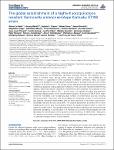The global establishment of a highly-fluoroquinolone resistant Salmonella enterica serotype Kentucky ST198 strain
Hello, Simon Le
Bekhit, Amany
Granier, Sophie A.
Barua, Himel
Beutlich, Janine
Zając, Magdalena
Münch, Sebastian
Sintchenko, Vitali
Bouchrif, Brahim
Fashae, Kayode
Pinsard, Jean-Louis
Sontag, Lucile
Fabre, Laetitia
Garnier, Martine
Guibert, Véronique
Howard, Peter
Hendriksen, Rene S.
Christensen, Jens P.
Biswas, Paritosh K.
Cloeckaert, Axel
Rabsch, Wolfgang
Wasyl, Dariusz
Doublet, Benoit
Weill, François-Xavier
While the spread of Salmonella enterica serotype Kentucky resistant to ciprofloxacin across Africa and the Middle-East has been described recently, the presence of this strain in humans, food, various animal species (livestock, pets, and wildlife) and in environment is suspected in other countries of different continents. Here, we report results of an in-depth molecular epidemiological study on a global human and non-human collection of S. Kentucky (n = 70). We performed XbaI-pulsed field gel electrophoresis and multilocus sequence typing, assessed mutations in the quinolone resistance-determining regions, detected β-lactam resistance mechanisms, and screened the presence of the Salmonella genomic island 1 (SGI1). In this study, we highlight the rapid and extensive worldwide dissemination of the ciprofloxacin-resistant S. Kentucky ST198-X1-SGI1 strain since the mid-2000s in an increasingly large number of contaminated sources, including the environment. This strain has accumulated an increasing number of chromosomal and plasmid resistance determinants and has been identified in the Indian subcontinent, Southeast Asia and Europe since 2010. The second substitution at position 87 in GyrA (replacing the amino acid Asp) appeared helpful for epidemiological studies to track the origin of contamination. This global study provides evidence leading to the conclusion that high-level resistance to ciprofloxacin in S. Kentucky is a simple microbiological trait that facilitates the identification of the epidemic clone of interest, ST198-X1-SGI1. Taking this into account is essential in order to detect and monitor it easily and to take rapid measures in livestock to ensure control of this infection.
Dateien zu dieser Publikation
Keine Lizenzangabe

